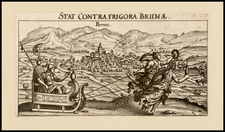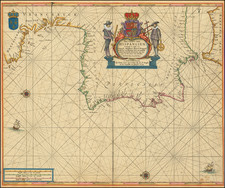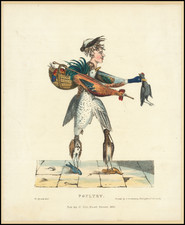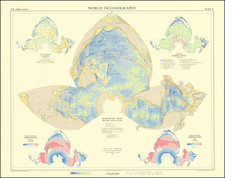Possibly The Earliest Printed Image of the Spanish Armada Setting Sail for England -- Second Known Example
Very rare Italian engraving depicting the Spanish Armada in formation near Lisbon. This is only the second known example of the print, and the first known outside of Europe.
The image depicts the Armada off the coast of Lisbon on May 29, 1588. The title describes the Armada as the "Army of the Catholic King," sailing en route to combat, with 197 ships arrayed in a tight crescent with the commanders’ ships at center.
The image is quite extraordinary, as it provides a contemporary record of the launching of the Armada at a time when the level of enthusiasm, pride and commitment to the venture in Spain and Rome (the likely place of publication) would have been at its apex. Within two months, the venture would prove to be an unmitigated disaster for Philip II, defender of the Catholic faith, and certainly would not have inspired the engraving of a print such as this. This likely explains both the rarity of this print specifically and the lack of similar, later Italian graphic images of the Armada.
The print shows the Armada with each squadron headed by a significant Hapsburg nobleman. The key below identifies sixteen different ships/groupings, each identifying either a commanding officer, a sponsoring noble or the region from which the ships were sponsored (for example the Admiral of the Galleons of Castlile). Notably, the right cone was under the command of Juan Martínez de Recalde, second-in-command of the entire venture who would die of illness only days after limping back to Spain in October 1588. The titles remind us that the Armada may have been a Spanish plan, but the participants were from the far-flung Hapsburg realms, with officers hailing from Italy, various parts of Spain, and Portugal. The ships were also of different sizes and designs; item thirteen mentions a fleet of galleys, which are identifiable by their oars.
Lisbon is shown as a small bird’s eye view, situated on the Portuguese coastline. Portugal at this time was recently united with the Spanish Crown (1580). The city was the departure point of the Armada in late May of 1588. While Philip’s forces were one of the largest naval flotillas ever assembled to that time, it is slightly exaggerated here. Rather than nearly 200 vessels, there were roughly 130 with 7,000 sailors, 17,000 soldiers, and 1,300 officials that left Portugal to sail north.
Many of these ships would eventually be sunk or run aground as the Armada suffered on its long return voyage around the British Isles. For example, item eleven identifies a ship commanded by Juan Gómez de Medina. This is likely the Gran Grifón, the flagship of the supply squadron made up of Baltic ships. Damaged in the Channel, the ship made it into the stormy North Sea. The Gran Grifón attempted to call at Fair Isle, but a strong tide meant that it wrecked at Stroms Hellier. Gómez de Medina and his men were then stranded for several weeks until the owner of Fair Isle rescued them and took them to Quendale. They then went to Orkney, St. Andrews, and Edinburgh before boarding ships for Spain. Fifty of the men died of disease while still on Fair Isle, and half of the remaining survivors were attacked by a Dutch ship on the way home. The wreck was excavated in 1970.
The Spanish Armada
The defeat of the Spanish Armada is one of the foundational events in the construction of English national identity. Usually billed as a clash between Catholic Spain and Protestant England, there were several factors that led Philip II to assemble the Armada.
Religion certainly played a role, and tensions especially mounted after Elizabeth ordered the execution of her Catholic cousin, Mary, a crowned Queen of Scotland and France, in February 1587. Philip II saw himself as the defender of the Catholic faith. He was also a former King of England, as Parliament granted him that title when his wife, Mary Tudor, ruled from 1554 to 1558. Ironically, Philip ordered the reorganization and strengthening of the remnants of Henry VIII’s navy, a decision he would later regret. Philip sought Pope Sixtus V’s blessing and financial support in 1587, painting the Armada as a crusade against heretics.
However, Philip also had important political reasons for seeing Elizabeth and England as a threat. In 1585, Elizabeth enacted several agreements, called the Treaty of Nonsuch, which pledged English troops and funds for the Dutch, who were in open revolt against Spain.
Philip declared war in response, allowing for the buccaneer and nobleman Francis Drake to lead a series of raids on Spanish possessions in the Atlantic in 1585-6. He sacked Vigo, Spain; Santiago, Cape Verde Islands; Santo Domingo, and Saint Augustine, Florida. His greatest achievement was the capture of Cartagena, one of the most important Spanish colonial cities.
Philip began to gather ships from across his Hapsburg holdings at Lisbon and Cadiz. To add insult to injury, Drake struck again, destroying 24 Spanish ships at the latter port. In the words of the Venetian ambassador to Madrid, Hieronimo Lippomano, “this woman [Elizabeth I] has shown the world how they [the English] can strike at the Spaniard in Flanders, in the Indies and in his own house” (as quoted in Jackson, 47).
The Spanish recovered from Drake’s raid, however, and still managed to assemble the formidable fleet seen here. The initial invasion plan was developed by Philip’s most successful and skilled admiral, Don Alvaro de Bazan, the Marquis of Santa Cruz. However, Santa Cruz died in February of 1588, delaying the attack and depriving Spain of its most brilliant naval tactician.
Instead, Philip recruited Alonso Pérez de Guzmán, the Duke of Medina Sedonia. Medina Sedonia tried to avoid the appointment, citing his lack of naval experience, his family and landed responsibilities, and his propensity for seasickness as reasons for his lack of suitability. Philip was unimpressed, however. Medina Sedonia has been ill-treated by historians, but it is thanks to his considerable administrative skills that the Armada came together at all.
Lisbon was a natural staging area for a venture like the Armada; the entrance to the Tagus is well defended by forts and the port itself has a considerable capacity for large ships. The final plan was to sail to the Low Countries, where the Armada would pick up the Duke of Parma’s army of 30,000 men. This invasion force would then be landed in Kent and the army and navy would proceed up the Thames toward London. The plan depended on fair weather and surprise, neither of which the Spanish encountered.
The fleet sailed on May 28, 1588. They almost immediately hit a storm. The ships rendezvoused in La Coruña, leaving there on July 22. They sailed northwest, appearing off the Cornish coast a week later. This ignited a series of skirmishes along the southern English coast. On August 6, the English, under the command of Charles Howard, Lord Effingham, managed to attack the fleet, forcing them into open waters. Worse for Medina Sedonia, Parma’s army was not quite ready to board, compelling him to wait off of Calais.
Just after midnight of the morning of August 8, the English sent a series of fire ships toward the Spanish vessels at anchor. The Spanish managed to intercept or dodge all of them, but at the cost of their formation and many of their valuable anchors. The following day saw the Battle of Gravelines, a decisive English victory. While much is made of the so-called Protestant Wind that saved the English, on that day, the wind barely managed to save the Spanish ships from the rocks of the French coast. The Armada lumbered northward, scattering as it headed toward Scottish waters.
It was in the North Sea that the wind decisively turned against the Spanish, resulting in numerous shipwrecks on the Scottish and Irish coastlines. Fewer than two-thirds of the Spanish vessels returned to Hapsburg ports, and half of the men died. The entire episode left Spain weakened and England grateful to have survived such a massive attack from the world’s leading superpower.
Publication and rarity
As the image is unsigned, there is a likelihood that it was not intended for commercial distribution and may have been commissioned specifically to honor the primary sponsors of the Armada. Certainly, after the defeat of the Armata at the end of July 1588, no Italian publisher would have found a market (or even a publication privilege) for graphics celebrating the doomed venture.
The image was almost certainly engraved in Rome shortly after the Armada set sail in late May 1588. The only other surviving example of the print is in the collection of the National Library of Malta, whose collection of this type of material consists of 132 items, most of which were printed in Rome by the printing house of Pietro de Nobili. Between 1586 and 1588, de Nobili worked with Marcello Clodio and Girolamo Arbotti. However, there is no definitive means for identifying the maker as one of these men.
This is an extremely rare print, showing an important historical event from a vantage seldom considered for such a well-known episode.











![[ Bornos and Zahara de la Sierra ] Bornnes [with:] Zahara](https://storage.googleapis.com/raremaps/img/small/96138.jpg)
![[Grotto of Tethys -- Versailles] Le Soleil qui se couche dans la mer / Le Globe de la Terre, divise en six parties.](https://storage.googleapis.com/raremaps/img/small/79606.jpg)

